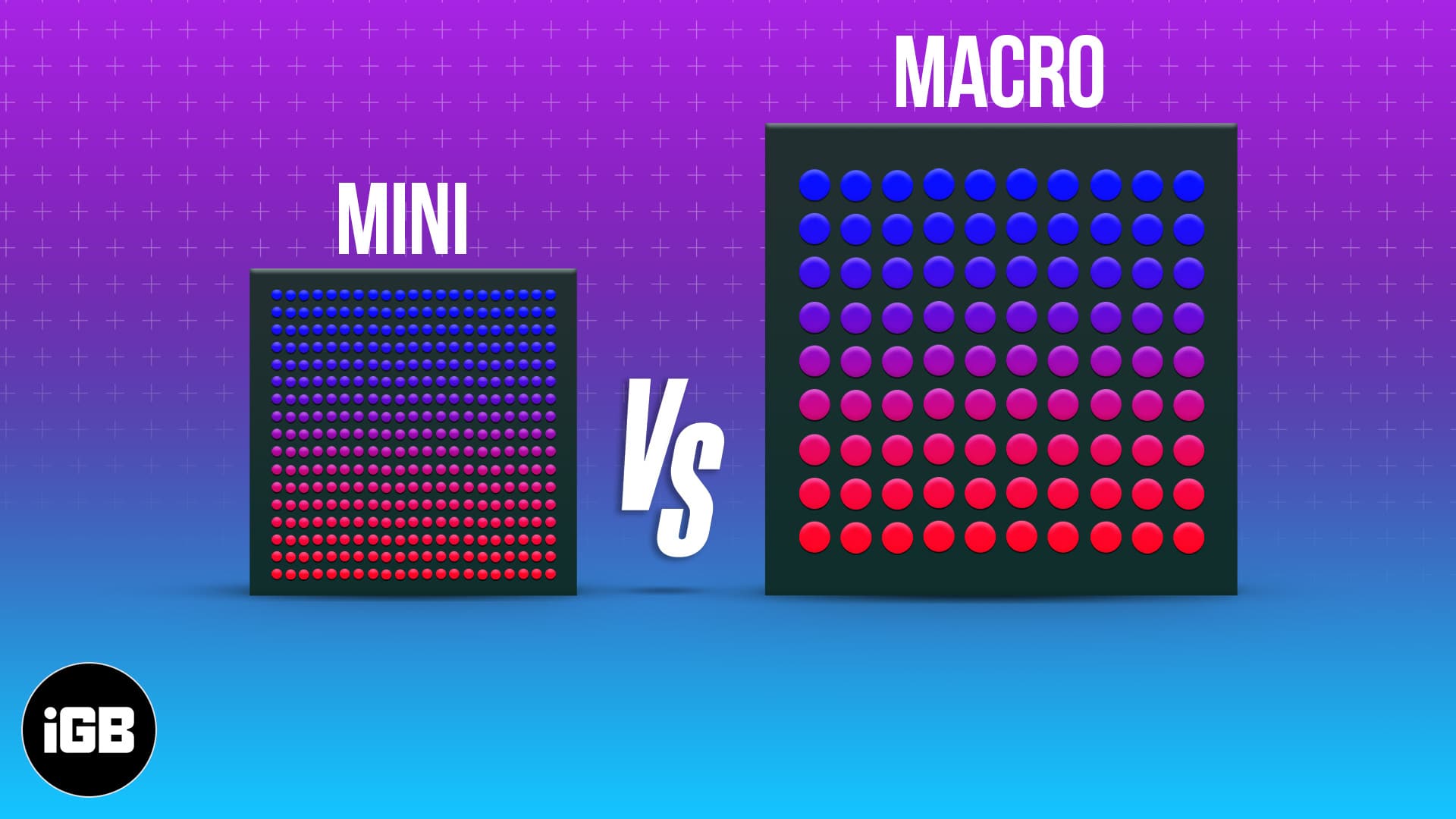We’ve seen technical words like mini-LED and micro-LED being used for TV displays lately. I’d never really paid attention to these terms until Apple started using them. I mean, how can TV displays be used for MacBooks and iPads, right?

Trust me, the terms may look complicated, and it can be intimidating at first, but they’re pretty fun to understand.
Let’s clear the basics of Mini-LED vs. Micro-LED out now, shall we?
Understanding LEDs
One of the simplest components in modern technology, LED stands for “light-emitting diode”. As the name suggests, these tiny gadgets emit light when a current passes through them. Yes, it’s that simple. Give it current, it’ll light up!
Take the current from it; it’ll go dark!
LED first appeared in consumer products in the 60s and has been evolving ever since. The improvements have led to a brighter display and over 16.9 million color combinations. LEDs are not restricted to TV displays or MacBook screens; they’re used everywhere, from infrared remote controls to digital displays.
LEDs are tiny diodes, and a combination of LEDs makes a display. There are different types of LED displays available including, OLEDs, mini-LEDs, micro-LEDs, etc.
Let’s take a further look and get to know their importance.
What is a mini-LED?

Mini-LEDs are smaller diodes with sizes ranging from less than 0.2nm. (1m = 1,000,000,000nm). Apple used LCD panels in their display. These displays have LEDs in them for backlighting purposes.
Depending on the type of display, LEDs are fully lit up or dimmed down, especially for darker scenes.
MacBooks currently uses a strip of LEDs at the bottom of the display, while the PRO Display XDR comes with 576 LEDs.
The sole difference between a traditional LED setup and a mini-LED setup is that a mini-LED display can have more than a thousand LEDs. Apple is exploring using more than 10,000 LEDs each for its recent products, each LED below 200 microns.
What is a micro-LED?

They may seem similar, but micro-LEDs have a tiny difference that sets them apart. Micro-LEDs are tinier and offer a much more vibrant display. Current micro-LEDs are as small as 50μm. This is 1/100th the size of a conventional LED.
Mini-LEDs refine the existing LCD backlight, and micro-LEDs look even more promising and versatile. They can go head to head with OLED and offer brighter, more vivid colors.
The best way to understand micro-LED pixels is to think of those vast backdrops at college events. Now think about the amount of light they have to produce, and the visible pixels on the screen. Can we use these displays on our home screens? No, because they’re far too low-resolution. Watching movies on these screens would not be a pleasant viewing experience.
On the other hand, microscopic LEDs, which are already more diminutive in size, cumulate a high-resolution display suitable for a home environment.
Comparison: micro-LED vs. mini-LED
Theoretically, both displays are the best versions of their older counterparts. The pieces have become smaller and more compact, and the contrast, brightness, and darkness levels have steadily improved over the years.
What if you have to choose between the two for your next purchase? We’ve got you covered.
Size
Now here’s a win for micro-LED. Micro-LEDs don’t have any restrictions on their size. If you wish to increase their size, add more micro-LED panels to your screen. Whereas with mini-LEDs, they have to stick to the conventional sizes in TVs or MacBooks.
Become an iGeeksBlog Premium member and access our content ad-free with additional perks.
Contrast: brightness and darkness levels
When you’re talking about the display, you want to see options for adjusting the brightness and contrast levels independently. In this case, micro LED emerges as the ultimate victor.
Imagine you want your screen to be totally black; a micro-LED display will make it happen. The same goes for the brightness levels.
Every pixel emits its original colors and brightness because no other backlights control it. Since the pixels are individually controlled, the contrast levels can be managed with the television set. In conclusion, Micro LED is the ultimate winner.
Why is Apple adopting a mini-LED display?
Apple is developing multiple iPads and MacBooks that can incorporate mini-LED technology, according to the popular rumor monger Ming-Chi Kuo. Apple will come up with mini-LED displays in the coming events.
- 16-inch MacBook Pro
- 14.1-inch MacBook Pro
- 12.9-inch iPad Pro
- 27-inch iMac Pro
- Low-cost iPad
- iPad mini
Based on the rumors, it sounds like Apple’s ultimate plan is to shift its processors to M1 and its screens (iPad to Mac) to mini-LED display. The M1 MacBook being launched this year may be the first product to receive a micro-LED upgrade.
When to expect mini-LED technology
The first-generation mini-LED products were expected in 2020, but we didn’t see that happening due to the pandemic. Kuo predicting getting the devices in before WWDC this year.
FAQs of mini-LED vs. micro-LED
LED stands for light-emitting diode.
Both are different technologies, which cannot be compared in the same boat. The comparison is largely due to effective marketing strategies by leading companies. However, if the displays were to be compared, OLED comes out on top.
No, the materials and production cost to build a mini-LED is pretty steep, which brings the affordability factor down.
Apple is promoting mini-LEDs for their compactness, flexibility with lighting settings, and affordability.
Foldable iPhones are being made with QLED and flexible OLED display arrangements. Mini-LEDs are not the right fit for foldable iPhones.
Which display is right for me?
Both the displays have their pros and cons—ultimately, it’s not a defining factor. Choose the device that fits your needs and budget the best.
We hope this guide helped you understand the mini-LED vs. micro-LED comparison better.
You may also like:
